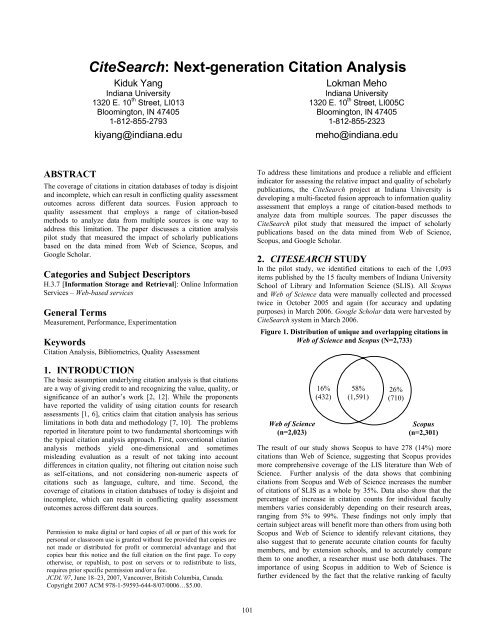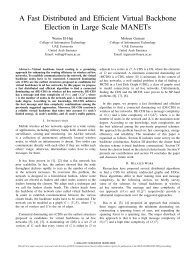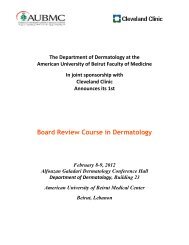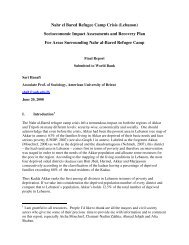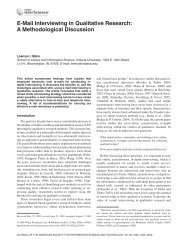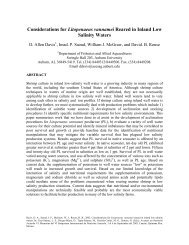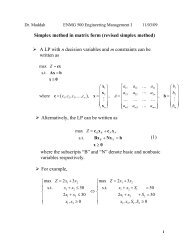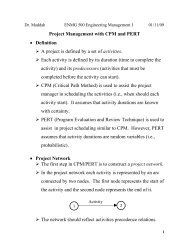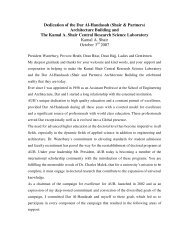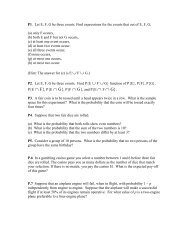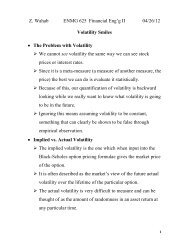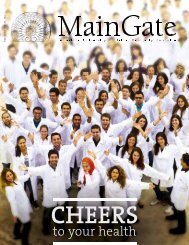CiteSearch: Next-generation Citation Analysis - American University ...
CiteSearch: Next-generation Citation Analysis - American University ...
CiteSearch: Next-generation Citation Analysis - American University ...
You also want an ePaper? Increase the reach of your titles
YUMPU automatically turns print PDFs into web optimized ePapers that Google loves.
<strong>CiteSearch</strong>: <strong>Next</strong>-<strong>generation</strong> <strong>Citation</strong> <strong>Analysis</strong>Kiduk YangIndiana <strong>University</strong>1320 E. 10 th Street, LI013Bloomington, IN 474051-812-855-2793kiyang@indiana.eduLokman MehoIndiana <strong>University</strong>1320 E. 10 th Street, LI005CBloomington, IN 474051-812-855-2323meho@indiana.eduABSTRACTThe coverage of citations in citation databases of today is disjointand incomplete, which can result in conflicting quality assessmentoutcomes across different data sources. Fusion approach toquality assessment that employs a range of citation-basedmethods to analyze data from multiple sources is one way toaddress this limitation. The paper discusses a citation analysispilot study that measured the impact of scholarly publicationsbased on the data mined from Web of Science, Scopus, andGoogle Scholar.Categories and Subject DescriptorsH.3.7 [Information Storage and Retrieval]: Online InformationServices – Web-based servicesGeneral TermsMeasurement, Performance, ExperimentationKeywords<strong>Citation</strong> <strong>Analysis</strong>, Bibliometrics, Quality Assessment1. INTRODUCTIONThe basic assumption underlying citation analysis is that citationsare a way of giving credit to and recognizing the value, quality, orsignificance of an author’s work [2, 12]. While the proponentshave reported the validity of using citation counts for researchassessments [1, 6], critics claim that citation analysis has seriouslimitations in both data and methodology [7, 10]. The problemsreported in literature point to two fundamental shortcomings withthe typical citation analysis approach. First, conventional citationanalysis methods yield one-dimensional and sometimesmisleading evaluation as a result of not taking into accountdifferences in citation quality, not filtering out citation noise suchas self-citations, and not considering non-numeric aspects ofcitations such as language, culture, and time. Second, thecoverage of citations in citation databases of today is disjoint andincomplete, which can result in conflicting quality assessmentoutcomes across different data sources.Permission to make digital or hard copies of all or part of this work forpersonal or classroom use is granted without fee provided that copies arenot made or distributed for profit or commercial advantage and thatcopies bear this notice and the full citation on the first page. To copyotherwise, or republish, to post on servers or to redistribute to lists,requires prior specific permission and/or a fee.JCDL’07, June 18–23, 2007, Vancouver, British Columbia, Canada.Copyright 2007 ACM 978-1-59593-644-8/07/0006…$5.00.To address these limitations and produce a reliable and efficientindicator for assessing the relative impact and quality of scholarlypublications, the <strong>CiteSearch</strong> project at Indiana <strong>University</strong> isdeveloping a multi-faceted fusion approach to information qualityassessment that employs a range of citation-based methods toanalyze data from multiple sources. The paper discusses the<strong>CiteSearch</strong> pilot study that measured the impact of scholarlypublications based on the data mined from Web of Science,Scopus, and Google Scholar.2. CITESEARCH STUDYIn the pilot study, we identified citations to each of the 1,093items published by the 15 faculty members of Indiana <strong>University</strong>School of Library and Information Science (SLIS). All Scopusand Web of Science data were manually collected and processedtwice in October 2005 and again (for accuracy and updatingpurposes) in March 2006. Google Scholar data were harvested by<strong>CiteSearch</strong> system in March 2006.Figure 1. Distribution of unique and overlapping citations inWeb of Science and Scopus (N=2,733)Web of Science(n=2,023)16%(432)58%(1,591)26%(710)Scopus(n=2,301)The result of our study shows Scopus to have 278 (14%) morecitations than Web of Science, suggesting that Scopus providesmore comprehensive coverage of the LIS literature than Web ofScience. Further analysis of the data shows that combiningcitations from Scopus and Web of Science increases the numberof citations of SLIS as a whole by 35%. Data also show that thepercentage of increase in citation counts for individual facultymembers varies considerably depending on their research areas,ranging from 5% to 99%. These findings not only imply thatcertain subject areas will benefit more than others from using bothScopus and Web of Science to identify relevant citations, theyalso suggest that to generate accurate citation counts for facultymembers, and by extension schools, and to accurately comparethem to one another, a researcher must use both databases. Theimportance of using Scopus in addition to Web of Science isfurther evidenced by the fact that the relative ranking of faculty101
members changes in eight out of 15 cases. In addition, Scopusretrieves considerably more citations from refereed conferencepapers than Web of Science (359 vs. 229). 54% of citations fromconference papers are uniquely found in Scopus in comparison toonly 28% in Web of Science (20% of citations from conferencepapers are found in both databases). This could have significantimplications for citation analyses and the evaluation of individualscholars, especially when those evaluated include authors who useconferences as a main channel of scholarly communication.The findings suggest that many of the previous studies that usedWeb of Science exclusively to generate citation data to evaluateand/or rank scholars, journals, programs, and so on have beenbased on skewed and incomplete data and may have resulted ininaccurate assessments and imprecise rankings. Given the lowoverlap in citations between the two databases, the findingsfurther suggest that the use of Scopus in addition to Web ofScience may have significant implications on the h-index scoresof authors and journals [3, 5], and journal impact factors [4, 9].Figure 6. Distribution of unique and overlapping citations inGoogle Scholar and WoS_Scopus (N=5,285)Google Scholar(n=4,181)48%(2,552)31%(1,629)21%(1,104)Union of Wos & Scopus(n=2,733)In contrast to Web of Science and Scopus, which index citationsmainly from journal articles and conference papers, citationsfound through Google Scholar come from many different types ofdocuments. Results show that Google Scholar identifies 1,448(53%) more citations than Web of Science and Scopus combined(4,181 vs. 2,733) and combining citations from all three sourcesincreases the number of citations by 93% (from 2,733 to 5,285citations). In other words, one would miss over 93% of relevantcitations if searching were limited to Web of Science and Scopus.Despite the large increase in citation counts, adding GoogleScholar’s unique citations data to those of Web of Science andScopus does not significantly alter the relative ranking of facultymembers—Spearman Rank Order correlation coefficient = 0.976at 0.001 level. Google Scholar also misses 1,104 (40%) of the2,733 citations found by Web of Science and Scopus (Figure 2).This is strikingly high, especially given the fact that virtually allcitations from Web of Science and Scopus come from refereedand/or reputable sources.Given the fact that Google Scholar is so cumbersome to use,misses a significant number of citations from refereed sources,and has little or no influence on the relative rankings of scholars,one could conclude that, as far as LIS is concerned, GoogleScholar is superfluous, especially when the focus of a study is oncitations in refereed journals and conference proceedings andwhen both Web of Science and Scopus are used to generatecitation counts for assessing and comparing scholars, journals,and academic departments to one another. Google Scholar,however, could be very useful for individual scholars preparingfor tenure and promotion and/or for comparative citation analysisstudies that attempt to map or visualize scholarly networks [11,13] and/or those studies that try to show one’s internationalimpact [8]. It should be emphasized here that Google Scholaruncovers many unique citations (2,552 or 48% of the 5,285citations found in all three sources) that could be very useful insuch studies or for such purposes (Figure 2).REFERENCES[1] Adkins, D., & Budd, J. (2006). Scholarly productivity ofU.S. LIS faculty. Library & Information Science Research,28(3), 374-389.[2] Cronin, B. (1984). The citation process: The role andsignificance of citations in scientific communication.London: Taylor Graham.[3] Cronin, B., & Meho, L. (2006). Using the h-index to rankinfluential information scientists. Journal of the <strong>American</strong>Society for Information Science and Technology, 57(9),1275-1278.[4] Garfield, E. (1996). How can impact factors be improved?British Medical Journal, 313 (7054), 411-413.[5] Hirsch, J. E. (2005). An index to quantify an individual’sscientific research output. Proceedings of the NationalAcademy of Sciences of the United States of America,102(46), 16569-16572. Retrieved February 15, 2006, fromhttp://www.pnas.org/cgi/reprint/102/46/16569.[6] Holmes, A., & Oppenheim, C. (2001). Use of citationanalysis to predict the outcome of the 2001 ResearchAssessment Exercise for Unit of Assessment (UoA) 61:Library and Information Management. InformationResearch, 6(2). Retrieved June 15, 2005, fromhttp://informationr.net/ir/6-2/paper103.html.[7] MacRoberts, M.H., & MacRoberts, B.R. (1996). Problems ofcitation analysis. Scientometrics, 36(3), 435-444.[8] Nisonger, T.E. (2004). <strong>Citation</strong> autobiography: Aninvestigation of ISI database coverage in determining authorcitedness. College & Research Libraries, 65(2), 152-163.[9] Nisonger, T. E. (2004). The benefits and drawbacks ofimpact factor for journal collection management in libraries.The Serials Librarian, 47(1-2), 57-75.[10] Seglen, P.O. (1998). <strong>Citation</strong> rates and journal impact factorsare not suitable for evaluation of research. ActaOrthopaedica Scandinavica, 69(3), 224-229.[11] Small, H. (1999). Visualizing science by citation mapping.Journal of the <strong>American</strong> Society for Information Science,50(9), 799-813.[12] van Raan, A.F.J. (1996). Advanced bibliometric methods asquantitative core of peer-review based evaluation andforesight exercises. Scientometrics, 36(3), 397-420.[13] White, H. D., & McCain, K. W. (1997). Visualization ofLiteratures. Annual Review of Information Science andTechnology, 32, 99-168.102


